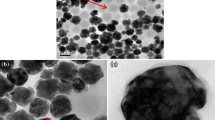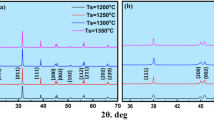Abstract
Commercial raw materials for multilayer ceramic capacitors—barium titanate (BT) and ammonium polyacrylate (APA) dispersant—were examined for lot-to-lot variations which cause poor reproducibility in BT slips and in capacitor chips. Two lots of BT supplied by a commercial source were different with respect to surface species examined by Fourier-transform infrared spectroscopy, X-ray photoelectron spectroscopy, electrokinetic sonic amplitude and total carbon analysis. It was found that there was more APA dispersant chemisorption on BT when the BT surface was more hydroxylated and less carbonated. For the dispersant, the two lots differed in pH and ammonium ion content. The amount of APA dispersant adsorbed on BT depended more on the ceramic powder surface species than on the chemical differences in APA lots.
The electrokinetic sonic amplitude (ESA) and zeta potentials of the two lots of as-received BT were small but positive. The BT lot with more surface hydroxyls exhibited slightly higher zeta potential values. The BT with more carbonate was more stable in terms of aging rate in water. Aging in water increased the positive zeta potential by increasing Ba2+ dissolution and adsorption. With the APA dispersant, the BT surface became less positive, but more stable and exhibited an isoelectric point of∼10.6. It can be concluded that the dispersion of BT in the as-dispersed pH range is mainly by steric stabilization with little contribution from electrostatic charges.
Similar content being viewed by others
References
S.A. Constantino, Am. Ceram. Soc. Bull., 71, 787 (1992).
R. Nami, Ceramic Industry, 1996, p. 25.
B.H. Marks, Electronics, 21, 116 (1948).
R.C. Bradt and G.S. Ansell, J. of Am. Ceram. Soc., 52, 192 (1969).
K.W. Plessner, Proc. Phys. Soc. (Physical Society, London, 1956) 69 (444B) p. 1261.
M.C. McQuarrie and W.R. Bussem, Amer. Ceram. Soc. Bull., 34, 402 (1955).
Proc. Center for Dielectric Studies Symp. on Improvement of Multilayer Capacitors Reliability, (Penn State Univ., University Park, PA, 1989).
J.C. McLarney, Aging effect in barium titanate dielectric (Master's Thesis, Clemson Univ., 1970).
C. Harard, A. Faivre, and J. Lemaitre, J. European Ceram. Soc., 15, 135 (1995).
W. Huebner, S.A. Anderson, H.U. Anderson, and J. Brannon, in Ref. 7, p. 257.
J.H. Adair, R.E. Chodelka, S.A. Costantino, and S. Vegnigalla, Elelectroceramic Device ManufacturingWorkshop, April 1–11, 1997, State College, PA.
D.V. Miller, J.H. Adair, and R.E. Newnham, Ceramic Trans., Vol. 1. Cermaic Powder Sci. IIB, G.L. Messing, E.R. Fuller, Jr., H. Hausner, eds., Am. Ceram. Soc., Westerville, OH, 1988, p. 493.
D.A. Anderson, J.H. Adair, D. Miller, J.V. Biggers, and T.R. Shrout, Ceramic Trans., Vol. 1. Cermaic Powder Sci. IIB, G.L. Messing, E.R. Fuller, Jr., H. Hausner, eds., Am. Ceram. Soc., Westerville, OH, 1988, p. 485.
C.C. Hung and R.E. Riman, in Chemical Processing of Adv. Materials, edited by L.L. Hench and J.K. West (Wiley Science, New York, 1992), p. 603.
Sadtler IR Spectra, No. 74989K, Y27K, Y28K, Y188K, Y249K, and 47558P (Sadtler Research Lab., Inc., Philadelphia, PA, 1976).
K. Nakamoto, Infrared Spectra of Inorganic and Coordination Compounds (John Wiley, New York, 1963).
Sadtler IR Spectra No. 74989K (Bio Rad Lab., Inc., Philadelphia, PA, 1988).
L.H. Little, Infrared Spectra of Adsorbed Species (Academic Press, New York, 1966), p. 77.
P.J. Balaz, J. Briancin, Z. Bastl, L. Medvecky, and V. Sepelak, J. Mat. Sci. 29, 4847 (1994).
A.R. Mathiesen and J.V. McLaren, J. Polym. Sci., Part A: Polym. Chem., 3, 2555 (1965).
D.H. Lee, P.A. Condrate Sr., and J.S. Reed, in Ceramic Trans., Vol, 54, edited by J.H. Adair, J.A. Casey, C. Randall and S. Venigalla (Am. Ceram. Soc., Westerville, OH 1995), p. 67.
E.A. Bekturov and Z. Kh. Bakauova, Synthetic Water-Soluble Polymers in Solution (Huthig and Wepf Verlag, Heidelberg, Germany, 1986).
K.F. Tjipangandjara and P. Somasundaran, in Proc. of 2nd World Congress of Particle Techn., Effect of the conformation of polyacrylic acid on the dispersion-occulation of alumina and kaolinite fines (Kyoto, Japan, 1990).
A. Fossy, A. Attar, and J.M. Lamarch, J. Colloid Interfac. Sci., 96, 275 (1983).
R.W. O'Brien, J. Fluid Mech., 190, 77 (1988).
R.W. O'Brien, W.N. Rowlands, and R.J. Hunter, in Ceramic Transaction Vol. 54, Characterization of ceramic materials using electroacoustics, edited by J.H. Adair. J.A. Casey, C.A. Randall, and S. Venigalla (Am. Ceramic Soc., Westerville, OH, 1995), p. 53.
D.W. Cannon, in Electroacoustic for Characterization of Particulate and Suspensions, NIST Pub. No. 856, edited by S.G. Malghan, (National Institute of Science & Technology, Gaithersburg, 1993), p. 40.
H. Polat, M. Polat, and S. Chander, in Electroacoustic for Characterization of Particulate and Suspensions, NIST Pub. No. 856, edited by S.G. Malghan, (National Institute of Science & Technology, Gaithersburg, 1993), p. 200.
U. Paik, J. Korean Phys. Soc., 32, S1224 (1998).
V. Hackley and S. Malghan, in Electroacoustic for Characterization of Particulate and Suspensions, NIST Pub. No. 856, edited by S.G. Malghan, (National Institute of Science & Technology, Gaithersburg, 1993), p. 161.
F.N. Desai, H.R. Hammad, and K.F. Hayes, in Electroacoustic for Characterization of Particulate and Suspensions, NIST Pub. No. 856, edited by S.G. Malghan, (National Institute of Science & Technology, Gaithersburg, 1993), p. 129.
Y.C. Huang, N.D. Sanders, F.M. Fowkes, and T.B. Lloyd, in Electroacoustic for Characterization of Particulate and Suspensions, NIST Pub. No. 856, edited by S.G. Malghan, (National Institute of Science & Technology, Gaithersburg, 1993), p. 180.
J.-H. Jean and H.-R. Wang, J. Am. Ceram. Soc., 81, 1589 (1998).
Z. Chen, T.A. Ring, and J. Lemaitre, J. Am. Ceram. Soc., 75, 3201 (1992).
A. Dutta, in Electroacoustic for Characterization of Particulate and Suspensions, NIST Pub. No. 856, edited by S.G. Malghan, (National Institute of Science & Technology, Gaithersburg, 1993), p. 274.
R.J. Hunter, Foundation of Colloid Science, Oxford Univ. Press, New York, 1987, p. 91.
Author information
Authors and Affiliations
Rights and permissions
About this article
Cite this article
Lee, B.I. Chemical Variations in Barium Titanate Powders and Dispersants. Journal of Electroceramics 3, 53–63 (1999). https://doi.org/10.1023/A:1009966900092
Issue Date:
DOI: https://doi.org/10.1023/A:1009966900092




